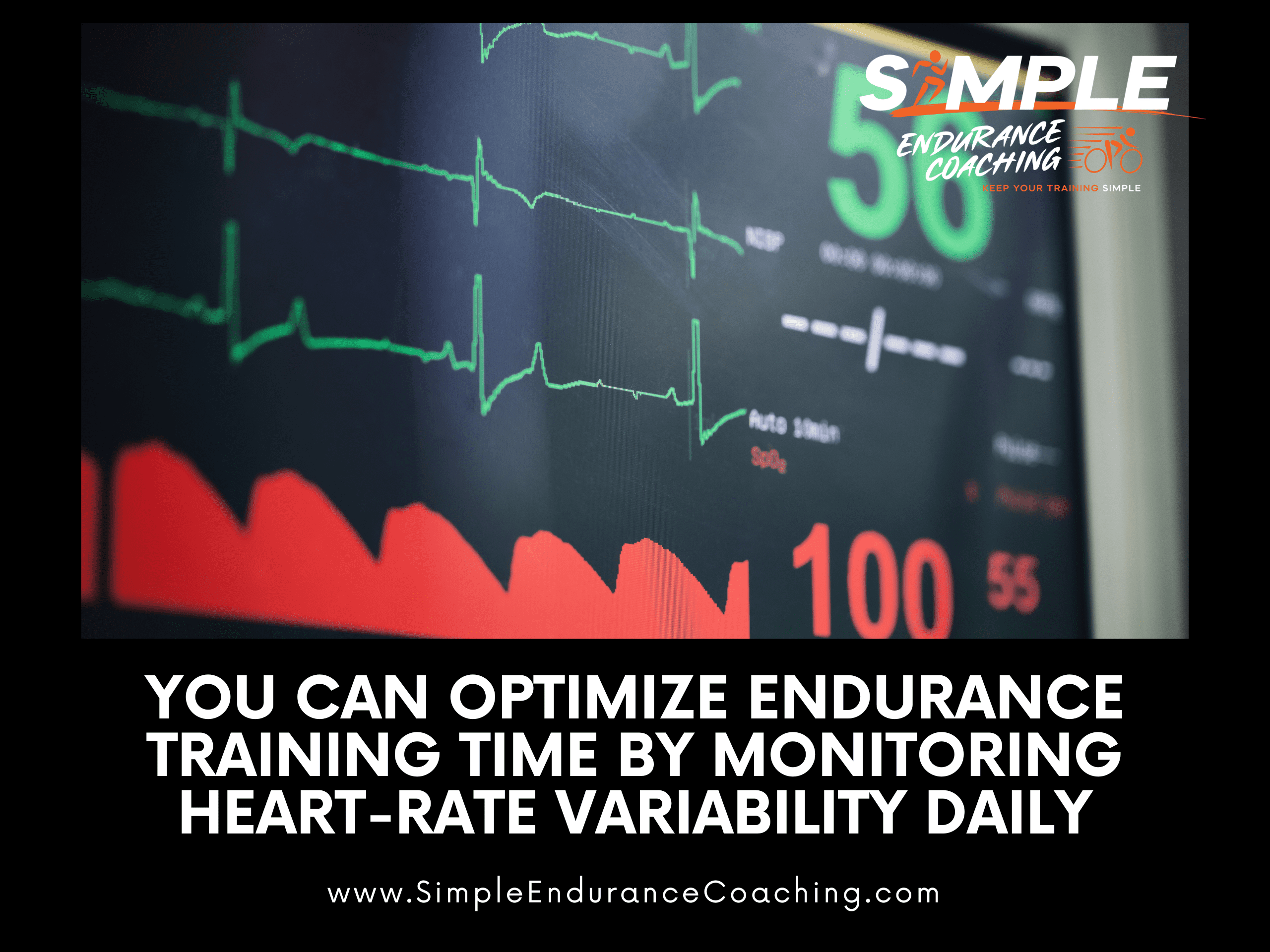You can optimize endurance training time by monitoring heart rate variability daily
Do you want to take your endurance performance to the next level?
Then it’s time for you to discover the power of personalized training through HRV-based programs.
By tracking and analyzing your heart rate variability, you can tailor workouts, recovery periods, and nutrition plans to optimize your endurance training time.
Plus monitoring your HRV helps you understand how sleep, alcohol consumption, and general life stress contribute to your training readiness.

HRV measures life stress, not just training stress
When it comes to endurance training, there’s no one-size-fits-all approach.
That’s because every athlete is different, and what works for one person may not work for another.
That’s where heart rate variability (HRV) comes in.
HRV is a measure of the beat-to-beat changes in your heart rate.
It’s a way to track how your body is responding to training as well as life stress, and it can be used to customize your training program to better meet your needs.
Several devices measure heart rate variability
There are a few different ways to measure HRV, such as a heart rate strap or watch.
These devices use sensors to track your heart rate and then calculate your HRV based on the data they collect.
However, the evidence suggests that devices that continually measure HRV might not be the most accurate.
I use HRV4Training and recommend it to all of my clients.
This app uses your phone’s camera to measure your heart rate and uses an algorithm to calculate your HRV and other data.
HRV helps adjust training load
Once you have your HRV data, you can use it to adjust your training volume and intensity to ensure that you’re not overdoing it or underdoing it.
This can help you avoid overtraining and injury, and it can also help you maximize your endurance performance.
Most HRV monitors provide a recommendation about your daily training readiness.
These are not rock-solid recommendations, but more suggestions.
For example, if I get yellows several days in a row or one red day, I’ll take a day off.
Otherwise, I’m good to go for volume or intensity.
Continue to build load, instead of relying on arbitrary schedule
There are many benefits to using an HRV-based training program to enhance your endurance performance.
First, HRV-based programs allow you to customize your training based on your body’s response to exercise.
This means that you can tailor your workouts specifically to your own needs, which can lead to better results.
You can continue to train and build up training stress until your body essentially tells you it’s had enough.
Additionally, HRV-based programs can help you monitor your progress and ensure that you are consistently improving.
Finally, HRV-based training can help you avoid overtraining and burnout by providing guidance on how much volume and intensity you should be doing at each stage of your training.
Growing body of research supporting the use of HRV for endurance performance
There is a growing body of research supporting the use of HRV for endurance performance.
A recent study found that athletes who used HRV-based training programs had significantly greater improvements in VO2max and running economy than those who did not use HRV-based training programs.
The same study also found that HRV-based training was more effective than traditional training programs.
Other studies have shown that HRV can be used to predict changes in running performance and to optimize training load.
For example, one study found that runners who increased their weekly mileage by 10% while maintaining their HRV scores improved their 5K time by an average of 3 minutes.
Further, well-trained cyclists using HRV to guide their training increased their time trial performance and overall power.
Use heart-rate variability to determine intensity
There are a few different ways to use HRV to guide your training.
The most common method is to use it to determine how hard you should train on any given day. This is usually done by looking at your HRV score for the day and using that as a guide.
For example, if your score is low, you might want to skip the intensity training and do an easy endurance day.
If your score is high, you might be able to do a long volume day or an intensity day.
Use HRV to see long-term training response
Another way to use HRV is to help you plan your training over the course of a week or month.
This can be done by looking at trends in your HRV scores over time.
If you see that your scores are consistently low, you might want to adjust your training accordingly.
For instance, you might add more easy days or cut back on the volume of training.
On the other hand, if you see that your scores are consistently high, you might be able to increase the intensity or volume of your training.
Within a block of training, for example, you might see that your HRV stays consistent, meaning you are responding well to the training stimulus.
Heart-rate variability is a supplement to your training metrics
On the plus side, HRV can help you to more accurately gauge your level of fatigue and recovery, which can allow you to tailor your training more effectively.
Additionally, HRV can provide insights into how well your body is adapting to training stress, which can help you to avoid overtraining.
But it’s important to understand that any HRV monitor, even HRV4Training, is just one tool to monitor your fitness.
There will be days when you feel amazing but your HRV shows yellow.
Likewise, there will be days when the HRV shows green, but you feel horrible!
The HRV should be a supplement to how your body is feeling.
Here are three things to know about endurance training time by monitoring heart rate variability
- HRV is a great tool to measure all of your stress, including training and life.
- Heart-rate variability is just one tool to monitor your daily training readiness.
- HRV can also be a great tool to notice trends in how your respond to training.
Want to know more about what you can achieve?
If you liked this article, please share it with others.
I support a limited number of cyclists and runners achieve their goals with more strength, endurance, and mobility.
Contact me or sign up for Virtual Coffee so we can discuss your goals, ask questions, and talk about making your endurance training more effective, fun, and Simple.
You can also opt-in to receive my weekly blog posts about what works in endurance sports.
Paul Warloski is a:
- USA Cycling Level 3 Coach
- RRCA Running Coach
- Training Peaks Level 2 Coach
- RYT-200 Yoga Instructor
- Certified Personal Trainer





